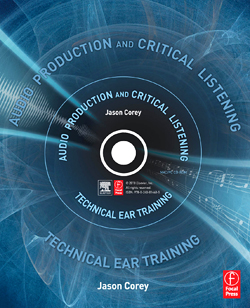
The release time affects mostly the decay of the sound. The decay portion of the sound is that which becomes quieter after the loud onset.
If the release time is set long, then the compressor gain does not quickly return to unity after the signal level has fallen below the threshold (which happens during the decay).
With a long release time, the natural decay of the drum sound becomes significantly reduced.
When compressing a mix of an entire drum kit, it becomes more apparent that the attack time is affecting the spectral balance of the total sound.
Increasing the attack time from a very short value to something longer, increases the low-frequency energy coming from the bass drum.
As attack time is lengthened from near zero to several tens or hundreds of milliseconds, the spectral effect is similar to adding a low-shelf filter to the mix and increasing the low-frequency energy.
Compression and Vocals
Because vocal performances tend to have a wide dynamic range, engineers often find that some sort of dynamic range control helps them reach their artistic goals for a given recording.
Compression can be very useful in reducing the dynamic range and de-essing a vocal track.
Unfortunately, compression does not always work as transparently as desired, and artifacts from the automated gain control of a compressor sometimes come through.
A couple of simple tips can help reduce dynamic range without adding too many of the side effects that can detract from a performance:
- • Use low ratios. The lower the ratio, the less gain reduction that will be applied. Ratios of 2:1 are a good place to start.
• Use more than one compressor in series. By chaining two or three compressors in series on a vocal, each set to a low ratio, each compressor can provide some gain reduction and the effect is more transparent than using a single compressor to do all of the gain reduction.
To help identify when compression is applied too aggressively, listen for changes in timbre while watching the gain reduction meter on our compressor.
If there is any change in timbre that is synchronized with gain reduction, the solution may be to lower the ratio or raise the threshold or both. Sometimes a track may sound slightly darker during extreme gain reduction, and it can be easier to identify synchronous changes when watching the gain reduction meter of a compressor.
A slight popping sound at the start of a word or phrase may indicate that the attack time is too slow.
Generally a very long attack time is not effective on a vocal since it has the effect of accentuating the attack of a vocal and can be distracting.
Compression of a vocal usually brings out lower-level detail in a vocal performance such as breaths and “ s ” sounds. A de-esser, which can reduce the “ s ” sound, is simply a compressor that has a high-pass filtered (around 5 kHz) version of the vocal as its side chain or key input. De-essers tend to work most effectively with very fast attack and release times.
To purchase Audio Production and Critical Listening: Technical Ear Training click on over to the Focal Press website.
Jason Corey is an assistant professor of audio engineering and performing arts technology at the University of Michigan School of Music, Theatre & Dance and an active member of the Audio Engineering Society.
